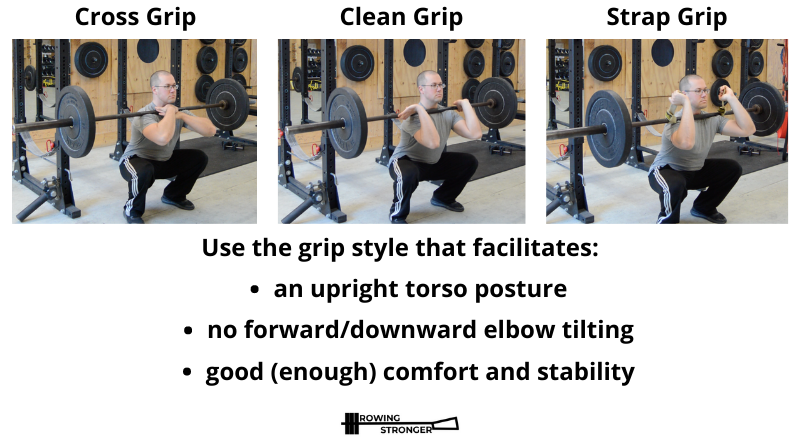Move of the Month: The Front Squat
by GRP strength coach Will Ruth
The front squat is my favorite squat for rowers. Properly performed with good technique, full range of motion, and control of the lowering and lifting phase tempo, I’ve seen the greatest improvement in rowing technique and performance from this lift than any others.
Stability and power at the front end of the drive phase is among the most valuable qualities for performance in the modern era of rowing and sculling with hatchet blades and erg training. The front squat builds leg strength and control through the hips, torso, and shoulders to achieve this.
I prefer the front squat to the back squat for a few reasons. First, tall or long-limbed rowers usually find it easier to reach a full depth at the bottom position of thighs just below parallel to the floor with good technique. Second, the forward bar position of the front squat facilitates a more upright torso posture, which reduces shear stress on the lower back and encourages the rower to squat from a good position. For example, a common rower error is popping the hips up first from the bottom position of a squat. The back squat will let you get away with this, but in a front squat, the bar rolling forward makes it clearer to the athlete that this is not the desired technique. Finally, with equal load the front squat results in more leg, trunk, and shoulder muscle activation than the more posteriorly shifted back squat. I’ve found the front squat to be a more relevant exercise for rowing performance and the target muscles for stroke technique, power, and endurance.
Watch my demonstration video and review the following key technique pointers:
The torso should stay in one piece throughout the lift with no or very minimal movement at the back and shoulders. I cue athletes “the feet move the bar” to get at this idea that the hips and trunk are just there to transfer force from the ground to the bar.
Rest the bar across the collarbones in the groove between the neck and shoulders. Use either a clean-style grip, cross grip, or strap grip, whichever is more comfortable (or “less uncomfortable”) for you. I find that rowers usually do better with the cross grip. The torso should support the weight, not the hands or wrists.
Descend as far as you’re able to with good technique, with an eventual goal of getting the top of the thighs just below parallel to the floor. Use a 2-to-1 lowering-to-lifting tempo to emphasize control on the lowering phase and acceleration on the lifting phase.
Rowers new to strength training should begin with the bodyweight squat or dumbbell/kettlebell goblet squat to develop the general squatting movement pattern and lower body strength. Progress to the front squat when you feel ready and/or can no longer hold a heavy enough weight in the goblet position to achieve lower body challenge. I recommend training the squat for more sets of lower reps (3-5 sets of 3-10 reps) with higher outputs for strength and power. Use single-leg squat exercises (more about these in a future MOTM) for higher reps for a more muscular focus (2-4 sets of 8-15 reps), and then use aerobic cross-training and sport training (erging, rowing, sculling) to train endurance.

